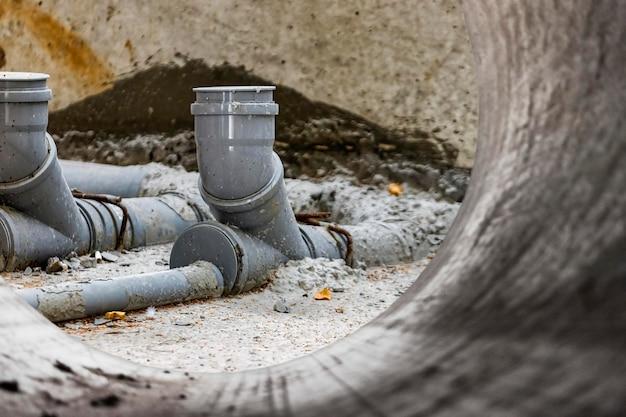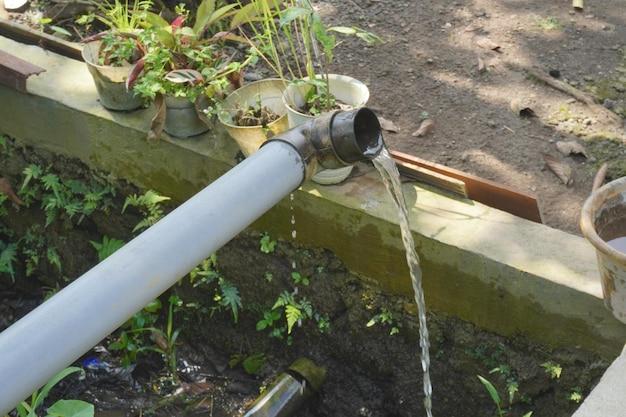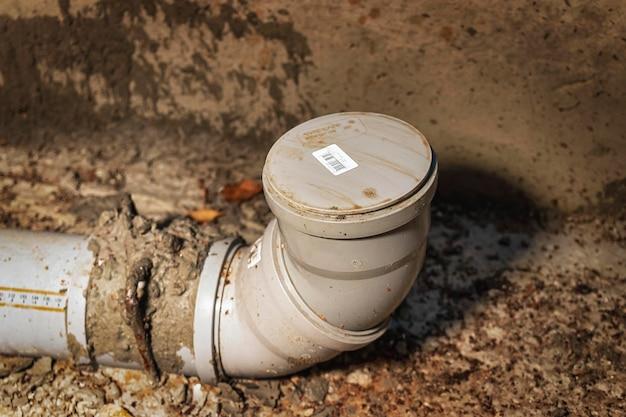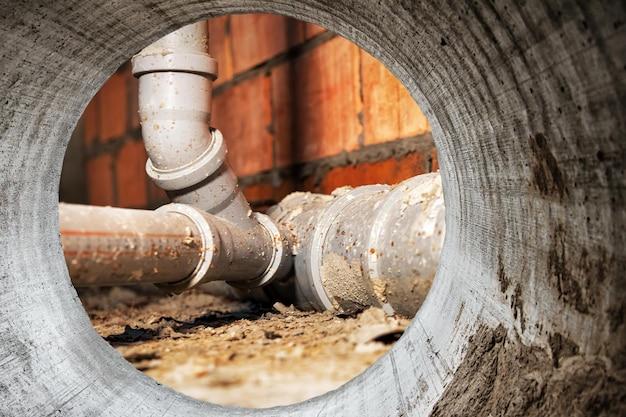Maintaining your sewer line is crucial for preventing costly and messy plumbing issues in your home. One essential component of a well-functioning sewer system is a cleanout. But what exactly is a cleanout? How do you install one? And why would you need two cleanouts? In this blog post, we’ll answer all your questions about cleanout installation and explore the differences between one-way and two-way cleanouts. So, let’s dive in and discover how to make your sewer line maintenance a breeze!
Installing a Cleanout for Your Sewer Line
If you’ve ever dealt with a clogged sewer line, you know it’s not a situation you want to find yourself in. Installing a cleanout may not sound like the most exciting task, but trust me, it’s a game-changer when it comes to preventing future plumbing disasters.
What Exactly is a Cleanout
Think of a cleanout as the easy-access door to your sewer line. It’s a pipe with a cap that allows plumbers to get in there and clear out any nasty blockages that may be causing you trouble. It’s like giving your sewer line a much-needed escape route, ensuring that any issues can be addressed quickly and efficiently.
When Do You Need to Install a Cleanout
The optimal time to install a cleanout is when your sewer line is being installed or replaced. However, don’t worry if you missed that opportunity. It’s never too late to introduce a cleanout to your plumbing system.
DIY or Call in the Pros
Now, before you grab your toolbox and start DIY-ing, keep in mind that installing a cleanout requires some plumbing expertise. If you’re confident in your skills and have experience handling plumbing projects, go for it. But if you’re like most of us who find the mysterious world of plumbing a bit intimidating, it’s best to call in the pros and let them work their magic.
The Installation Process, Simplified
Installing a cleanout involves a few key steps:
h3.Inspecting the Sewer Line
The first step is to inspect your sewer line to determine the ideal location for the cleanout. This is where a professional plumber truly shines, using their experience and expertise to identify the most suitable spot.
h3.Excavation and Pipe Connection
Once the location is determined, excavation is necessary to access the sewer line. The plumber will then connect the cleanout pipe to the sewer line, ensuring a secure and watertight connection.
h3.Installing the Cleanout and Cap
With the pipe connected, the plumber will install the cleanout itself, placing it at ground level for easy access. This cleanout will come equipped with a cap to seal it when not in use.
The Cleanout’s Role in Your Plumbing System
Now that you have a cleanout installed, you can bid farewell to those pesky clogs and plumbing nightmares. The cleanout provides a direct access point to your sewer line, allowing plumbers to effectively diagnose and resolve any blockages or issues that may arise in the future. It’s like having a secret weapon to keep your plumbing system running smoothly.
Remember, prevention is key when it comes to plumbing problems. So, consider giving your sewer line the gift of a cleanout—it’s a small investment that could save you from big headaches down the line.
How to Install a Cleanout: A Step-by-Step Guide
Gathering the Right Tools
Before we dive into the nitty-gritty details of installing a cleanout, let’s make sure we’ve got our toolbox in order. Here are the tools you’ll need:
- A sturdy shovel (because who doesn’t love a good shovel?)
- A measuring tape (because precision matters, folks)
- A reciprocating saw (for those who enjoy the sweet sound of power tools)
- PVC pipes and fittings (the building blocks of cleanout installation)
- Glue and primer (not the arts and crafts kind, unless you want a colorful sewer line)
Locating the Perfect Spot
Now that you’re armed with the right tools, it’s time to find a suitable spot for your cleanout. Remember, location is key! Here’s a step-by-step guide:
- Grab your shovel and start digging (think of it as a dirt treasure hunt).
- Locate the sewer line (also known as the “smelly culprit”).
- Measure the distance from the line to your desired spot (accuracy is paramount, my friend).
- Mark the spot with an “X” (because it’s more exciting than a boring old dot).
Digging Deeper (Literally)
Now comes the fun part: digging a lovely hole for your cleanout. But be warned, it’s not just child’s play. Follow these steps:
- Put on your favorite dirt-proof outfit (because stains are never in fashion).
- Start digging along the marked spot, ensuring you create a hole deep enough for your cleanout assembly (a hole with identity issues?).
- Keep digging until you hit the sewer line (cue dramatic music).
- Brush off the sweat and enjoy a sense of accomplishment (you’ve just become a pro digger).
Assembly Time
With the hole dug and the sewer line exposed, it’s time to assemble your cleanout. Here’s how:
- Take your PVC pipe and fittings (it’s like playing with a grown-up version of Legos).
- Cut a section of the sewer line using your trusty reciprocating saw (watch those fingers, kids).
- Attach the cleanout fitting to the cut section (think of it as a sewer line puzzle).
- Glue and prime the pieces together (it’s like a sewer line bonding ceremony).
Testing, Testing, 1, 2, 3
Congratulations, you’ve installed a cleanout! But before you break out the victory dance, let’s test your handiwork. Follow these final steps:
- Pour water down the drain (a mini waterfall in the pipes? So fancy!).
- Check for any leaks or mysterious gushing water (because surprises are overrated).
- Marvel at your cleanout installation skills (you’re now a sewer line superhero).
And there you have it — a comprehensive guide on how to install a cleanout. Now go forth, my friend, and conquer those clogged sewer lines with confidence and a touch of humor!
Two-Way Cleanout Installation
A two-way cleanout is a plumbing feature that allows easy access to the sewer line for maintenance and repairs. It is usually installed at the point where the sewer line connects to the main sewer system. Think of it as a sparkling entrance to a glamorous sewer party. But don’t worry, there won’t be any red carpets or paparazzi there!
Why Install a Two-Way Cleanout
Installing a two-way cleanout is like having a secret door to your sewer line. It gives you the power to quickly and efficiently clear blockages, inspect the pipes, and ensure everything is flowing smoothly. It’s like having a superhero cape for your plumbing system – only without the tights, of course.
DIY or Call a Professional
Installing a two-way cleanout might sound like a fun weekend project, but let’s face it – you probably have better things to do, like binge-watching your favorite show or perfecting your dance moves. It’s best to call a professional plumber because they have the knowledge, experience, and tools to do the job right. Plus, you wouldn’t want to accidentally turn your bathroom into a water park, would you?
The Installation Process
First things first, the plumber will locate the best spot to install the two-way cleanout. It’s like picking the perfect location for a secret hideout or a hidden treasure – except in this case, the treasure is a smooth-flowing sewer line. Once the spot is chosen and marked, the plumber will start digging. Don’t worry; they won’t be trying to find buried treasure or dinosaur fossils. It’s just a small trench to accommodate the new cleanout.
Next, the plumber will connect the two-way cleanout to the existing sewer line. It’s like assembling a Lego set, but instead of building a castle, you’re ensuring the proper flow of waste. The cleanout will be firmly secured in place, ready to be accessed whenever needed.
Finally, the plumber will test the cleanout to ensure it’s working correctly. They won’t be throwing a fancy party or inviting the neighborhood over, but they will make sure that everything is connected properly and that there are no leaks or blockages. It’s like quality control for your sewer line – because who wants a sewer line that doesn’t meet the highest standards?
Benefits of a Two-Way Cleanout Installation
Installing a two-way cleanout has many benefits, including:
- Easy access for cleaning and maintenance – think of it as having a VIP pass to your sewer line.
- Quick identification and resolution of blockages – no more guessing games or playing hide-and-seek with stubborn clogs.
- Preventing costly sewer line repairs – catching issues early on can save you from expensive headaches down the line.
- A cleaner and healthier sewer system – because nobody wants to live with a sewer line that’s unhappy or unhealthy.
Wrapping Up
Installing a two-way cleanout is a smart move for any homeowner. It grants you access to your sewer line whenever needed and ensures the smooth operation of your plumbing system. So, instead of stressing about clogs and backups, why not invest in a two-way cleanout and become the hero of your home’s plumbing? Your sewer line will thank you, even if it can’t say it out loud.
Why Do I Have Two Sewer Cleanouts
You may be puzzled as to why your humble abode needs not one, but two sewer cleanouts. Let’s clear up some misconceptions so you can continue your quest for the cleanest drains in town!
Two Heads Are Better Than One
Contrary to popular belief, having two sewer cleanouts isn’t an elaborate prank by mischievous plumbers. It’s actually a precautionary measure to ensure smoother sewage flow and easier access for maintenance.
Dual Pipes, Dual Cleanouts
Think of it this way: your home’s plumbing system is a bustling network of pipes, and with this complexity comes different responsibilities. The first cleanout usually connects to pipes responsible for your wastewater, while the second cleanout is dedicated to stormwater drainage.
Wastewater Woohoo!
The reason you have one cleanout for wastewater is because, well, you generate a fair amount of it! From the shower to the kitchen sink, and even the toilet (let’s not get into too much detail), your wastewater travels through a separate set of pipes connected to this cleanout. So, if you find yourself with drainage issues from these outlets, voila! You know which cleanout to check.
Stormwater Shenanigans
Now, let’s move on to the second cleanout, the one designated for stormwater drainage. When it rains cats and dogs, all that water needs to find its way out of your property, and it often comes with leaves, debris, and maybe even a rogue toy or two. This cleanout ensures easy access for removing any potential blockages caused by nature’s showers.
Keep ‘Em Clean!
Remember, having two cleanouts means double the responsibility. It’s crucial to keep both clean and clear of obstructions to maintain an efficient, odor-free plumbing system. Regular check-ups and occasional professional cleanings can work wonders!
The Hidden Benefits
Embrace the uniqueness of having two sewer cleanouts! While it may seem like extra work, it also grants you an advantage. In case there’s an issue with either wastewater or stormwater drainage, you’ll have a better idea of which cleanout to troubleshoot. It’s like having two keys to two different rooms—no need to fumble around in the dark!
Now that you understand the reasons behind having two sewer cleanouts, you can navigate the world of plumbing with confidence and a dash of humor. Embrace the quirkiness of your home’s plumbing system, and remember to keep those cleanouts spick and span for hassle-free drainage. Happy plumbing adventures!
Adding a Cleanout to a PVC Sewer Line
When it comes to maintaining your sewer line, having a cleanout is essential. It acts as a convenient access point, making it easier to inspect and clear any clogs or blockages. Think of it as a little window into the mysterious world of your sewer system.
Getting Your Hands Dirty
Adding a cleanout to your PVC sewer line may sound intimidating, but fear not, brave homeowner! With a few basic tools and a sprinkle of DIY magic, you’ll be able to tackle this project like a pro. Just remember to take it one step at a time and don’t be afraid to get your hands dirty. Trust us, your sewer line will be eternally grateful.
Gather Your Supplies
Before diving into the dirty work, make sure you have all the necessary supplies on hand. You’ll need PVC pipe and fittings, a cleanout adapter, pipe cleaner, primer, and glue. Oh, and don’t forget your trusty measuring tape. Precision is key when it comes to plumbing, my friend.
Measure Twice, Cut Once
Now that you’re all geared up, it’s time to measure and mark the spot where you’ll be installing the cleanout. Remember, accuracy is crucial here. Measure twice, cut once. You don’t want to end up with a cleanout in your neighbor’s yard. Unless, of course, your neighbor has always wanted a sewer-themed garden. In that case, kudos to you!
Cutting into Action
Once you’ve marked the spot, it’s time to get cutting. Use a PVC saw to carefully make a clean, straight cut in your sewer line. Remember to wear your safety goggles, because, well, we don’t want any sewer surprises ending up in your eyes.
Time to Attach the Cleanout
Now that you’ve made the necessary incision, it’s time to attach the cleanout adapter. Apply primer to both the inside of the adapter and the freshly cut end of the sewer line. Then, spread a generous amount of glue on both surfaces. Don’t be shy with the glue; this is one relationship where sticking together is a good thing.
The Finishing Touches
With the cleanout adapter securely in place, it’s time to connect the cleanout cap. Simply twist it onto the adapter, making sure it’s snug and watertight. Just like that, you’ve added a cleanout to your PVC sewer line. Give yourself a pat on the back. And maybe a high-five too, because you deserve it.
Celebrate Your Victory
Now that you’ve successfully conquered the task of adding a cleanout to your PVC sewer line, take a moment to bask in your DIY glory. Pour yourself a cold beverage, put your feet up, and revel in the fact that you’ve become a sewer line superhero. Cheers to you, my friend!
What is the Difference between a One-Way and Two-Way Cleanout
So, you’re strolling through the magical realm of plumbing knowledge, and you stumble upon the term “cleanout.” You scratch your head, wondering what it actually means. Well, my friend, a cleanout is like a superhero entrance point for your sewer line. But here’s the funny twist: there are two types of cleanouts — the one-way and the two-way. Let’s start with the one-way cleanout, the solo hero of the plumbing world.
Imagine a one-way cleanout as the stylish entrance to a glamorous party. Everyone can go in, but only the VIPs can come out. It’s like a checkpoint for any unwanted gunk or debris to make its great escape. This clever gadget ensures that nothing sneaky or nasty comes back up the sewer line and infiltrates your house. Think of it as the bouncer of the plumbing universe, audaciously guarding your home against any potential clogs or blockages.
Two-Way Cleanout: The Open-Door Policy 🚪
Now, let’s take a stroll to the other side of the plumbing universe and meet the cool cousin of the one-way cleanout: the two-way cleanout. Unlike its one-way sibling, this cleanout has an open-door policy. You know, like that friend who always keeps their doors open for anyone to drop by unannounced. Yeah, we all have that friend.
The two-way cleanout is basically a plumbing pitstop that allows for easy access from both directions. It’s like a secret underground tunnel connecting your sewer line and the outer world, giving you, the plumber hero, maximum maneuverability to get the job done. Need to send in some powerful cleaning tools or if you simply want to inspect the sewer line from both sides? No problemo! The two-way cleanout has got your back, making it a plumber’s dream come true.
Summing It Up: One-Way or Two-Way? You Decide! 🤔
In a nutshell, the difference between a one-way and two-way cleanout is all about the flow of traffic. The one-way cleanout keeps things moving in one direction, ensuring nothing unsavory crawls back up your sewer line. On the other hand, the two-way cleanout is all about flexibility, providing easy access from both ends for all your plumbing shenanigans.
So, the next time you find yourself deep in the realm of plumbing conundrums, remember to choose wisely: one-way or two-way? It all comes down to your needs and the type of adventures you want to embark on in the mysterious world beneath your home. Embrace the cleanout, my friend, and conquer those sewer line obstacles like the fearless plumber warrior you are! 💪🚽



